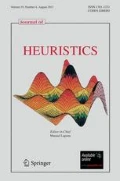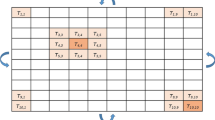Abstract
This paper describes a novel evolutionary algorithm inspired by the nature of spatial interactions in ecological systems. The Cellular Genetic Algorithm with Disturbances (CGAD) can be seen as a hybrid between a fine-grained and a coarse-grained parallel genetic algorithm. The introduction of a “disturbance-colonisation” cycle provides a mechanism for maintaining flexible subpopulation sizes and self-adaptive controls on migration. Experiments conducted, using a range of stationary and non-stationary optimisation problems, show how changes in the structure of the environment can lead to changes in selective pressure, population diversity and subsequently solution quality. The significance of the disturbance events lies in the new “ecological” patterns that arise during the recovery phase.
Similar content being viewed by others
References
Alvarez, L.W., W. Alvarez, F. Asaro, and H.V. Michel. (1980). “Extraterrestrial Causes for the Cretaceous-Tertiary Extinction.” Science 208, 1095–1108.
Belding, T.C. (1995). “The Distributed Genetic Algorithm Revisited.” In L. Eschelman (ed.), Proceedings of the Sixth International Conference on Genetic Algorithms, pp. 114–121.
Bentley, P.J. and J.P. Wakefield. (1997). “Finding Acceptable Solutions in the Pareto-Optimal Range using Multiobjective Genetic Algorithms.” In P. Chawdhry (ed.), Soft Computing in Engineering Design and Manufacturing. Berlin: Springer, Part 5, pp. 231–240.
Cantu-Paz, E. (1998). “ASurvey of Parallel Genetic Algorithms.” Calculateurs Parallels Reseaux et Systems 10(2), 141–171.
Cantu-Paz, E. (1999). “Topologies, Migration Rates and Multi-Population Parallel Genetic Algorithms.” In W. Banzhaf et al. (eds.), Proceedings of the 1999 Genetic and Evolutionary Computation Conference. San Mateo, CA: Morgan Kaufmann, pp. 91–98.
Cohoon, J.P., S.U. Hegde, W.N. Martin, and D. Richards. (1987). “Punctuated Equilibria: A Parallel Genetic Algorithm.” In J. Grefenstette (ed.), Proceedings of the Second International Conference on Genetic Algorithm. Lawrence Erlbaum Associates, pp. 148–154.
Connell, J.H. (1978). “Diversity in Tropical Rainforests and Coral Reefs.” Science 199, 1302–1310.
De Jong, K. (1975). An Analysis of the Behaviour of a Class of Genetic Adaptive Systems. PhD Thesis. Univeristy of Michigan.
De Jong, K. (1999). “Evolving in a Changing World.” In Z. Ras and A. Skowron (eds.), Foundation of Intelligent Systems. Lecture Notes in Artificial Intelligence, Vol. 1609. Berlin: Springer, pp. 513–519.
De Jong, K.A. and M. Potter. (1995). “Evolving Complex Structures via Cooperative Coevolution.” In J. R. McDonnell et al. (eds.), Evolutionary Programming IV, Proceedings of the Fourth Annual Conference on Evolutionary Programming. Cambridge: MIT Press, pp. 307–316.
Eldredge, N. and S.J. Gould. (1972). “Punctuated Equilbria: An Alterantive to Phyletic Gradualism.” In T.J.M. Schopf (ed.), Models in Paleobiology. Freeman: San Francisco, pp. 82–115.
Ellestrand, N.C. and D.R. Elam. (1993). “Population Genetic Consequences of Small Population Size: Implications for Plant Conservation.” Annual Review of Ecology and Systematics 24, 217–242.
Fonesca, C.M. and P. Flemming. (1995). “An Overview of Evolutionary Algorithms in Multi-Objective Optimization.” Evolutionary Computation 3(1), 1–16.
Goldberg, D.E. (1989). Genetic Algorithms in Search, Optimization and Machine Learning. Reading, MA: Addison-Wesley.
Goldberg, D.E. and R.E. Richardson. (1987). “Genetic Algorithms for Multimodal Function Optimization.” In Proceedings of the Second International Conference on Genetic Algorithms. San Mateo, CA: Morgan Kauffman, pp. 42–50.
Green, D.G. (1993). “Emergent Behaviour in Biological Systems.” In D.G. Green and T.R.J. Bossomaier (eds.), Complex Systems—From Biology to Computation. IOS Press, pp. 24–35.
Green, D.G. (1994). “Connectivity and the Evolution of Biological Systems.” Journal of Biological Systems 2(1), 91–103.
Green, D.G. and M.G. Kirley. (2000). “Adaptation, Diversity and Spatial Pattern.” International Journal of Knowledge-Based Intelligent Engineering Systems 4(3), 184–190.
Grefenstette, J. (1999). “Evolvability in Dynamic Fitness Landscapes: A Genetic Algorithm Approach.” In Proceedings of the Congress on Evolutionary Computation (CEC'99). IEEE Press. Vol. 3, pp. 1875–1882.
Holland, J.H. (1975). Adaptation in Natural and Artificial Systems. Ann Arbour: University of Michigan Press.
Holland, J.H. (1995). Hidden Order: How Adaptation Builds Complexity. Reading MA: Addison-Wesley.
Kareiva, P. (1990). “Population Dynamics in Spatially Complex Environments: Theory and Data.” Phils. Trans. R. Soc. Lond. 330, 175–190.
Kauffman, S. (1993). Origins of Order: Self Organisation and Selection in Evolution. Oxford: Oxford University Press.
Kirley, M. and D.G. Green. (2000). “An Empirical Investigation of Optimization in Dynamic Environments Using the Cellular Genetic Algorithm.” In D. Whitley et al. (eds.), Proceedings of the Genetic and Evolutionary Computation Conference (GECCO-2000). San Mateo, CA: Morgan Kaufmann, pp. 11–18.
Kirley, M., X. Li, and D.G. Green. (1998). “Investigation of a Cellular Genetic Algorithm that Mimics Landscape Ecology.” In R. MacKay et al. (eds.), Simulated Evolution and Learning—SEAL98, Volume 1585 Lecture Notes in Artificial Intelligence. Berlin: Springer, pp. 90–97.
Knowles, J. and Corne, D. (1999). “Local Search, Multiobjective Optimization and the Pareto Archived Evoltuionary Strategy.” In B. McKay et al. (eds.), Proceedings of the Third Australian-Japan Joint Workshop on Intelligent and Evolutionary Systems. ADFA. Univeristy UNSW, pp. 209–216.
Levin, S.A. (1998). “Ecosystems and the Biosphere as Complex Adaptive Systems.” Ecosystems 1, 431–436.
Lin, S., E.D. Goodman, and W. Punch. (1997). “Investigating Parallel Genetic Algorithms on Job Shop Scheduling Problems.” In P.J. Angeline (eds.), The Proceedings of the Sixth International Conference on Evolutionary Programming VI. (EP97). Berlin: Springer, pp. 383–394.
Manderick, B. and P. Spiessens. (1989). “Fine-Grained Parallel Genetic Algorithms.” In J.D. Schaffer (ed.), Proceeding of 3rd International Conference on Genetic Algorithms. San Mateo, CA: Morgan Kaufmannn, pp. 428–433.
Marin, J. and R.V. Sole. (1999). “Macroevolutionary Algorithms: A New Optimization Method on Fitness Landscapes.” IEEE Transactions on Evolutionary Computation 3(4), 272–286.
Muhlenbein, H. (1989). “Parallel Genetic Algorithms, Population Genetics, and Combinatorial Optimisation.” In J.D. Schaffer (ed.), Proceeding of Third International Conference on Genetic Algorithms. San Mateo, CA: Morgan Kaufmann, pp. 416–421.
Naeem, S. (1998). “Species Redundancy and Ecosystem Reliability.” Conservation Biology 12, 39–45.
Nowostawski, M. and R. Poli. (1999). “Dynamic Demes Parallel Genetic Algorithms.” In L.C. Jain (ed.), Proceedings of the Second Knowledge-Based Intelligent Information Engineering Systems Conference (KES99). IEEE Press, pp. 93–98.
Potter, M. and K. De Jong. (2000). “Cooperative Coevolution: An Architecture for Evolving Coadapted Subcomponents.” Evolutionary Computation 8(1), 1–29.
Raup, D. and J. Sepkoski. (1982). “Mass Extinctions in the Marine Fossil Record.” Science 215, 1501–1503.
Reice, S.R. (1994). “Nonequilibrium Determinants of Biological Community Structure.” American Scientist 82, 424–435.
Spears, W.M. (1995). “Adapting Crossover in Evolutionary Algorithms.” In J.R. McDonnell et al. (eds.), Proceedings of the Fourth Annual Conference on Evolutionary Programming. Cambridge, MA: MIT Press, pp. 367–384.
Solé, R.V., S.C. Manrubia, J. Pérez-Mercader, M. Benton, and P. Bak. (1998). “Long-Range Correlations in the Fossil Records and the Fractal Nature of Macroevolution.” Advances in Complex Systems 1, 255–266.
Sousa, W.P. (1984). “The Role of Disturbances in Natural Communities.” Annual Review of Ecology and Systematics 15, 353–391.
Tanese, R. (1989). “Distributed Genetic Algorithms.” In J.D. Schaffer (ed.), Proceedings of the Third International Conference on Genetic Algorithms. San Mateo, CA: Morgan Kaufmann, pp. 434–439.
Turner, M.G. and V.H. Dale. (1998). “Comparing Large Infrequent Disturbances: What Have We Learned?” Ecosystems 1, 493–496.
Tuson, A. and P. Ross. (1996). “Cost Based Operator Rate Adaptation: An Investigation.” In H.-M. Voigt et al. (eds.), Proceedings of the 4th Conference on Parallel Problem Solving from Nature. Volume 1141, Lecture Notes in Computer Science. Berlin: Springer-Verlag, pp. 461–469.
Van Veldhuizen, S.A and G.B. Lamont. (2000). “Multi-Objective Evolutionary Algorithms: Analyzing the Stateof-the-Art.” Evolutionary Computation 8(2), 125–147.
Vose, M.D. and G.E. Liepens. (1991). “Punctuated Equilibria in Genetic Search.” Complex Systems 5(1), 31–44.
Whitley, D. (1993). “Cellular Genetic Algorithms.” In S. Forest (ed.), Proceedings of the Fifth International Conference on Genetic Algorithms. San Mateo, CA: Morgan Kaufmann, pp. 658–662.
Wolpert, D.H. and W.G. Macready. (1997). “No Free Lunch Theorems for Optimization.” IEEE Transactions on Evolutionary Computation 1(1), 67–82.
Wright, S. (1943). “Isolation by Distance.” Genetics 28, 114–138.
Zitzler, E., K. Deb, and L. Thiele. (1999). “Comparison of Multi-Objective Evolutionary Algorithms: Empirical Results.” Evolutionary Computation 8(2), 173–196.
Author information
Authors and Affiliations
Rights and permissions
About this article
Cite this article
Kirley, M. A Cellular Genetic Algorithm with Disturbances: Optimisation Using Dynamic Spatial Interactions. Journal of Heuristics 8, 321–342 (2002). https://doi.org/10.1023/A:1015009818589
Issue Date:
DOI: https://doi.org/10.1023/A:1015009818589




